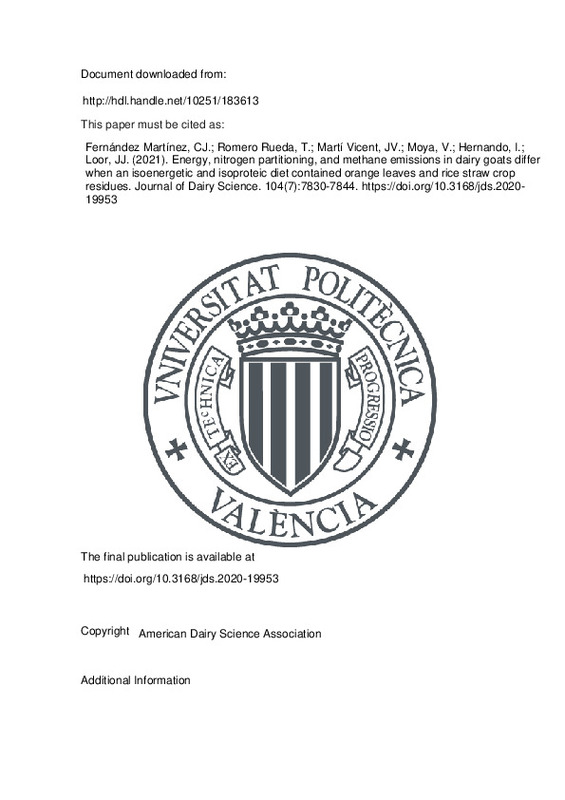JavaScript is disabled for your browser. Some features of this site may not work without it.
Buscar en RiuNet
Listar
Mi cuenta
Estadísticas
Ayuda RiuNet
Admin. UPV
Energy, nitrogen partitioning, and methane emissions in dairy goats differ when an isoenergetic and isoproteic diet contained orange leaves and rice straw crop residues
Mostrar el registro sencillo del ítem
Ficheros en el ítem
| dc.contributor.author | Fernández Martínez, Carlos Javier
|
es_ES |
| dc.contributor.author | Romero Rueda, Tamara
|
es_ES |
| dc.contributor.author | Martí Vicent, José Vicente
|
es_ES |
| dc.contributor.author | Moya, V.J.
|
es_ES |
| dc.contributor.author | Hernando, I.
|
es_ES |
| dc.contributor.author | Loor, J. J.
|
es_ES |
| dc.date.accessioned | 2022-06-27T18:06:28Z | |
| dc.date.available | 2022-06-27T18:06:28Z | |
| dc.date.issued | 2021-07 | es_ES |
| dc.identifier.issn | 0022-0302 | es_ES |
| dc.identifier.uri | http://hdl.handle.net/10251/183613 | |
| dc.description.abstract | [EN] The aim of this study was to evaluate the effects of incorporating rice straw and orange leaves into the diets for goats. Ten Murciano-Granadina goats at mid lactation weighing 45 +/- 0.3 kg were used in a crossover design. Two isoproteic and isoenergetic diets (180 g/kg DM and 17 MJ/kg DM, respectively) with alfalfa hay as forage source (33% of DM) were fed. A control diet (CON) incorporated barley as energy source and soy hulls as fiber component. The experimental diet (ORG) replaced barley and soy hulls with orange leaves (19% on DM basis), rice straw (12%, on DM basis) and soya oil (2%). Peas and horsebeans were the protein source in both diets. Each goat received the 2 treatments in 2 periods. Goats were fed the experimental diets and after 14 d on their respective treatments moved to individual metabolism cages for another 7 d. Subsequently, feed intake, total fecal and urine output and milk yield were recorded daily over the first 5 d. During the next 2 d ruminal fluid and blood samples were collected, and then individual gas-exchange measurements were recorded by a mobile open-circuit indirect calorimetry system using a head box. No differences in dry matter intake were detected, and apparent total-tract digestibility was greater in CON than ORG. Efficiency of metabolizable energy intake for milk and maintenance also was lower in response to ORG (0.65 vs. 0.63), with energy balance being negative (-12 kJ/kg of BW0.75) due to mobilization of fat (-16 g/animal vs. 68 g/animal for ORG and CON, respectively). Although actual milk yield was lower in goats fed ORG (2.32 vs. 2.06 kg/d, respectively), energy-corrected milk did not differ (2.81 kg/d on average). In terms of milk quality, milk fat content, and concentrations of monounsaturated (18.54 vs. 11.55 g/100 g milk fat) and polyunsaturated fatty acids (5.75 vs. 3.99 g/100 g milk fat) were greater in goats fed ORG. Based on various indices, the milk produced by ORG would be less atherogenic and thrombogenic than CON milk. Compared with CON, enteric CH4 emission was lower due to feeding ORG (reduction of 38 g CH4/kg milk fat). Data suggest that greater fat mobilization in goats fed ORG might have been due to the apparent lack of synchrony between degradable protein and carbohydrate and the lipogenic nutrients associated with the lower cereal content of the ORG diet. Thus, goats fed ORG seemed to rely more on fat depots to help meet energy requirements and reach optimal performance. As such, the lower content of glucogenic nutrients in ORG did not favor body fat deposition and partitioning of ME into body tissue. Overall, responses in terms of CH4 emissions and milk quality suggest that inclusion of rice straw and orange leaves in diets for small ruminants could be a valuable alternative to reuse, recycle and revalue agricultural by-products. | es_ES |
| dc.description.sponsorship | This study was supported by LIFE Project, Spain (ref. LIFE2016/CCM/ES/000088 LOW CARBON FEED), funded by the EU Commission (Brussels, Belgium). The authors have not stated any conflicts of interest. | es_ES |
| dc.language | Inglés | es_ES |
| dc.publisher | American Dairy Science Association | es_ES |
| dc.relation.ispartof | Journal of Dairy Science | es_ES |
| dc.rights | Reserva de todos los derechos | es_ES |
| dc.subject | Orange leaves | es_ES |
| dc.subject | Rice straw | es_ES |
| dc.subject | Dairy goat | es_ES |
| dc.subject | Methane emission | es_ES |
| dc.subject.classification | PRODUCCION ANIMAL | es_ES |
| dc.title | Energy, nitrogen partitioning, and methane emissions in dairy goats differ when an isoenergetic and isoproteic diet contained orange leaves and rice straw crop residues | es_ES |
| dc.type | Artículo | es_ES |
| dc.identifier.doi | 10.3168/jds.2020-19953 | es_ES |
| dc.relation.projectID | info:eu-repo/grantAgreement/COMISION DE LAS COMUNIDADES EUROPEA//LIFE16 CCM%2FES%2F000088//Climate Change Mitigation trough an innovative goat feed based on agricultural waste recycling/ | es_ES |
| dc.rights.accessRights | Abierto | es_ES |
| dc.contributor.affiliation | Universitat Politècnica de València. Departamento de Ciencia Animal - Departament de Ciència Animal | es_ES |
| dc.description.bibliographicCitation | Fernández Martínez, CJ.; Romero Rueda, T.; Martí Vicent, JV.; Moya, V.; Hernando, I.; Loor, JJ. (2021). Energy, nitrogen partitioning, and methane emissions in dairy goats differ when an isoenergetic and isoproteic diet contained orange leaves and rice straw crop residues. Journal of Dairy Science. 104(7):7830-7844. https://doi.org/10.3168/jds.2020-19953 | es_ES |
| dc.description.accrualMethod | S | es_ES |
| dc.relation.publisherversion | https://doi.org/10.3168/jds.2020-19953 | es_ES |
| dc.description.upvformatpinicio | 7830 | es_ES |
| dc.description.upvformatpfin | 7844 | es_ES |
| dc.type.version | info:eu-repo/semantics/publishedVersion | es_ES |
| dc.description.volume | 104 | es_ES |
| dc.description.issue | 7 | es_ES |
| dc.identifier.pmid | 33865581 | es_ES |
| dc.relation.pasarela | S\442691 | es_ES |
| dc.contributor.funder | COMISION DE LAS COMUNIDADES EUROPEA | es_ES |







![[Cerrado]](/themes/UPV/images/candado.png)

